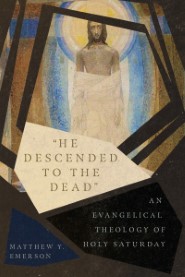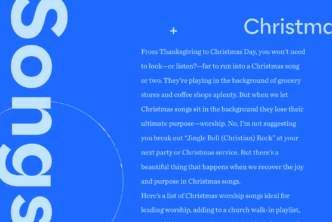For Catholics, Orthodox, and many Protestants, Holy Week is the most sacred time of the year. Traditionally, it is more important than Christmas, as it focuses on the central event of the gospel: the death and resurrection of Jesus.
Contents
The Paschal Mystery
Holy Week is an anticipation of the Lord’s Paschal Mystery. Pascha is an ancient way to speak of the events of Christ’s passion, death, and resurrection. It is a Greek word that corresponds to the Hebrew pesah, which means “pass over.” In the Jewish tradition, this word refers to the angel of death passing over the homes in Egypt that are marked with the blood of a lamb, and also to God’s people passing through the Red Sea to escape Pharaoh’s army.
Both meanings are present in Holy Week: Christ is the Lamb of God who causes death to pass over those marked with his blood, and he passes through the “Red Sea” (i.e., the grave) to deliver us from death, thereby defeating death by death. This is why we celebrate Easter on the Sunday after the Jewish Passover.
Holy Week: A Journey through the Passion Narrative
Each day of Holy Week is significant. The Four Gospels, taken together, cover a period of about three decades. However, most of the text in each Gospel is focused on just a three-day period. These are the most signficant events of Jesus’s life and ministry. In fact, about a third of each Gospel is dedicated to describing just the few hours between Jesus’s trial and death!
Holy Week is about commemorating these key events which preoccupied the Gospel writers.
Holy Week is also the last week of Lent, the penitential season comprising forty days of fasting. In the early church, Lent was the season of preparation for new converts—or catechumens—for baptism on Easter. Their preparation was seen as a communal responsibility, however—so everyone in the church community, even those already baptized, participated in the fast.
Holy Week starts on Palm Sunday and ends on Holy Saturday. So it begins on the high point of Christ’s earthly ministry and ends on the lowest point. Holy Week is followed directly by Easter (also called Resurrection Sunday), marking the beginning of Eastertide, which will continue until Pentecost.
Holy Week is also sometimes called “Passion Week” to refer to the suffering Jesus endured on our behalf. The English word passion comes from the Latin passio, “to suffer.”
Recommended books about Holy Week:

The Final Days of Jesus: The Most Important Week of the Most Important Person Who Ever Lived
Regular price: $12.99
1. Palm Sunday
Palm Sunday (also known as the Triumphal Entry) is the first day of Holy Week. It commemorates the day Jesus entered Jerusalem. He is astride a donkey. He is received with shouts and songs of joy. Cloaks and the branches of palm trees are spread in his path. This is a fulfillment of Zechariah 9:9, prophesied centuries beforehand: “Shout aloud, O daughter of Jerusalem! Behold, your king is coming to you; righteous and having salvation is he, humble and mounted on a donkey.”
It was common practice throughout the cultures of the Near East to cover the path of someone as a sign of the highest honor. At least one king from the Old Testament is reported to have been given this treatment (2 Kgs 9:13).
In short, by entering Jerusalem in this fashion, Jesus was declaring himself the king of Israel. This moment is the height of his earthly ministry. The size and enthusiasm of his following is at a peak. But it also has a mournful tone. Not much earlier, Jesus had predicted his own death. By “triumphing” (Col 2:15) in this manner, Jesus makes his ministry something the Roman authorities can no longer ignore: Jesus is presenting himself no longer as a mere teacher or prophet, but as an heir of David, and thus as a potential challenger of the Roman occupation of Palestine. So this day is also called Passion Sunday because it is the catalyst for the chain of events that lead to Golgotha.
But why palm trees, specifically?
Palm trees frequently appear in the religious symbolism of ancient Near Eastarn cultures. In Egypt, a palm branch was carried before funeral processions as a symbol of eternal life. In Rome, the palm branch was a symbol of triumph and mighty deeds. During Roman victory processions, representations of palm branches were prominent.
So both ancient symbols are at play, for Palm Sunday is at once a funeral procession and a victory march.
On this day, you’ll find churches opening their service with a long procession—sometimes through the nearby neighborhood—singing and waving palm branches. Children may weave these palms into the shape of a cross. a physical reminder of the palm branches strewn before Jesus and a foreshadowing of his death.
Many churches will later collect these palms to burn the following year the day before Ash Wednesday, the first day of Lent. (The day before Ash Wednesday is also called Shrove Tuesday, Fat Tuesday, or Pancake Day, because it is a last chance to stuff your face before the Lenten fast begins—but Shrove Tuesday is technically a popular holiday: it is not a liturgical holiday recognized in any official church calendar. No church calendar commends the observance of Fat Tuesday.) Those ashes will then be used to draw the sign of the cross on the forehead of any attending the Ash Wednesday service with the reminder, “You are dust, and to dust you will return” (Gen 3:19).
Learn more about Palm Sunday:
- What Is Palm Sunday? Plus, 3 Ideas for Observing It
- Palm Sunday, and Why the “Date” Is So Significant
2. Maundy Thursday
On Maundy Thursday, Jesus instituted and ate the Last Supper with the apostles. During the meal, Jesus took a towel and a basin of water and washed their feet, saying, “A new commandment I give to you, that you love one another” (John 13:34). The Latin word for commandment is mandatum, from which we get “maundy.”
So the Maundy, represented by foot washing, is the command to love one another as Christ loves us. Many churches have a worship service on Maundy Thursday where members of the assembly wash one another’s feet.
The new command is to do as Christ does. So it follows this does not end with foot washing, but extends to the cross itself. As Jesus says: “If anyone would come after me, let him deny himself and take up his cross and follow me” (Matt 16:24).
Christians believe in the priesthood of all believers. Through the gospel preached by the church, the world meets Christ and gains an audience with the Father. Thus in foot washing, which is a sort of “chrism” or “anointing,” we most visibly exercise our vocation to be “a kingdom of priests and a holy nation” (Exod 19:6). For this reason, many traditional churches will have some sort of footwashing service on this day.
Maundy Thursday is the last day of Lent. What follows is actually its own three-day “season”: the Triduum, which forms a sort of bridge crossing over from Holy Week to Eastertide.
Learn more about Maundy Thursday:
Recommended books about the atonement:
Christus Victor: An Historical Study of the Three Main Types of the Idea of Atonement
Regular price: $17.99
The Reconciling Wisdom of God: Reframing the Doctrine of the Atonement
Regular price: $14.99
3. Good Friday
Good Friday is the day of Jesus’s agony in the garden, betrayal by Judas, trial, crucifixion, and death. It is the first day of the paschal Triduum (Latin, “three days”), comprising Good Friday, Holy Saturday, and Easter. While we today tend to treat these as three discrete days, in the early church they were seen as a single unit.
In the Old Covenant, the High Priest would offer a lamb, kill it, and finally God would accept (or reject) it. In the New Covenant, Christ is acting as both High Priest and sacrificial lamb simultaneously. He offers himself up to his captors on Good Friday, is sealed in the tomb on Black Saturday, and the Father shows his acceptance of the Son’s sacrifice by raising him from the dead on Easter Sunday.
Just as we commemorate the resurrection of Jesus every Sunday by gathering to worship, many traditions since ancient times commemorate the betrayal and death of Jesus every Friday by setting aside that day of the week for fasting.
Significantly, the Gospel writers construe Christ’s crucifixion as a coronation. Christ is crowned with thorns, robed in purple, and elevated between heaven and earth on the cross (Matt 27:27–31; Mark 15:16–20; John 18:1–7). Pontius Pilate has written on a plaque above him: “The King of the Jews.” So the premise of Palm Sunday is strangely fulfilled: Christ is declared king and his throne is a cross. But the worshippers throwing palms before his path weren’t expecting this sort of king, a king whose glorification is his own crucifixion!
From the cross, the Son of Man quotes the opening of Psalm 22: “My God, my God, why have you forsaken me?” We are tempted to interpret this as a cry of despair, but it is not. His hearers know, even if they do not understand (not yet, anyhow), for they memorized this psalm as children and they know how it ends:
All the ends of the earth shall remember
and turn to the Lord,
and all the families of the nations
shall worship before you.
For kingship belongs to the Lord,
and he rules over the nations.
…
Posterity shall serve him;
it shall be told of the Lord to the coming generation;
they shall come and proclaim his righteousness to a people yet unborn,
that he has done it. (Ps 22:27–31)
Far from the cry of one abandoned, Jesus is declaring from the cross his future triumph. He will overcome both death and the world.
Many churches observe this day with a Tenebrae service focusing on the stations of the cross. During the service, the room slowly darkens. Often a loud noise will represent Christ’s death like a beating heart going silent. At the end of the service, the sanctuary is left in darkness and the worshippers stream out in silence.
Learn more about Good Friday:
- The Death Side of Life: Paul’s Scars and the Meaning of Good Friday
- What Good Friday Teaches Us about the Meaning of Suffering
- 5 Suggestions for Observing Good Friday
- Why Is Good Friday Called “Good”?
- The Beautiful Tragedy of Good Friday
Recommended books about Good Friday:
Cross Vision: How the Crucifixion of Jesus Makes Sense of Old Testament Violence
Regular price: $17.99
4. Holy Saturday
Holy Saturday marks the time that Jesus was in the tomb. He died yesterday and will rise tomorrow, but the interim is a time of uncertainty and aimless waiting. Most traditions that hold services for this day of Holy Week usually abstain from the Communion meal. Other churches have no service at all: a fitting response in its own way, since the One we worship (by appearances) isn’t there—he’s in a tomb! Holy Saturday is a seemingly endless night, for Hope has died. For this reason, it is also called Black Saturday.
Christ was buried just before sunset on Good Friday. On Black Saturday, at the request of Jewish leadership, Pontius Pilate grants a seal be set on the door of the tomb and a guard stationed. Meanwhile, the apostles tremble in their homes, bewildered by yesterday’s events.
As shame is the theme of Black Saturday, so the counter-lesson is the last lesson Jesus gave his disciples before his betrayal: “Watch and pray” (cf. Matt 26:41). Many churches appoint all-night vigils to pray on Black Saturday until dawn, incidentally imitating the restlessness of the disciples who, no doubt, were wondering if they had placed their faith in a false messiah.
Learn more about Holy Saturday:
Recommended books about Holy Saturday:

“He Descended to the Dead”: An Evangelical Theology of Holy Saturday
Regular price: $19.99
5. Easter Sunday and Eastertide
Though not technically part of Holy Week, it’s important to mention Resurrection Sunday here, as it marks the final day of the paschal Triduum—the day Jesus rose from the dead.
Churches commonly begin this Sunday in responsive celebration. The pastor or priest declares, “The Lord is risen!” The congregation joyously responds, “He has risen, indeed!” Some congregations raise a “holy noise” by clanging bells and noisemakers, shouting and signing—they even dance! Easter is one of only four traditional holy days where baptisms are performed (alongside Baptism of Our Lord, All Saints, and Pentecost).
However, Easter Sunday is not a single holiday. It is the first day of Eastertide! This ends on Pentecost, which is the day the Holy Spirit descended on Christ’s disciples, appearing like many tongues of fire.
The first forty days of Eastertide commemorate the forty days between Jesus’s resurrection and his ascension. The number forty recurs in Scripture: it rained forty days and forty nights in Noah’s day; Moses spent forty years in the wilderness before he was commissioned by God to lead the Hebrews out of Egypt; he also spent forty days on the mountain with God; the Hebrews wandered in the wilderness for forty years before arriving in the Promised Land; the city of Nineveh was given forty days to repent in Jonah’s day; for forty days, the giant Goliath of Gath taunted Saul’s army until the young David brought him down; the list goes on. This number seems to represent a time of testing or judgment followed by a great act of divine deliverance. It is a penitential number. So the fact that it is avoided during Eastertide is significant: the church is saying this is not a penitential season. This is a season for celebrating! Not to be outdone by the forty days of Lenten fasting, Easter Sunday commissions its own fifty-day season of paschal feasting!
Learn more about Easter:
- Is Easter a Pagan Holiday? Some Say Yes—but Is It Really?
- 10 Books on the Resurrection and Atonement
- The Resurrection of Jesus and 1 More Reminder of God’s Glory
- Pascha: How Eastern Orthodox Christians Celebrate the Resurrection
- How Ancient History Affirms the Resurrection of Jesus
- Is the Word “Easter” in the Bible?
- Why Did Jesus Appear to the Women instead of the Disciples?
Recommended resources about the resurrection:
Risen Indeed: A Historical Investigation Into the Resurrection of Jesus
Regular price: $26.99
Mobile Ed: NT156 The Significance of the Resurrection (2 hour course)
Regular price: $69.99
God with Us: The Meaning of the Cross and Resurrection—Then and Now
Regular price: $6.99








